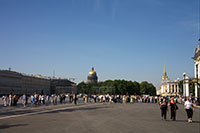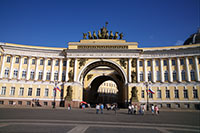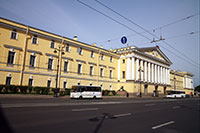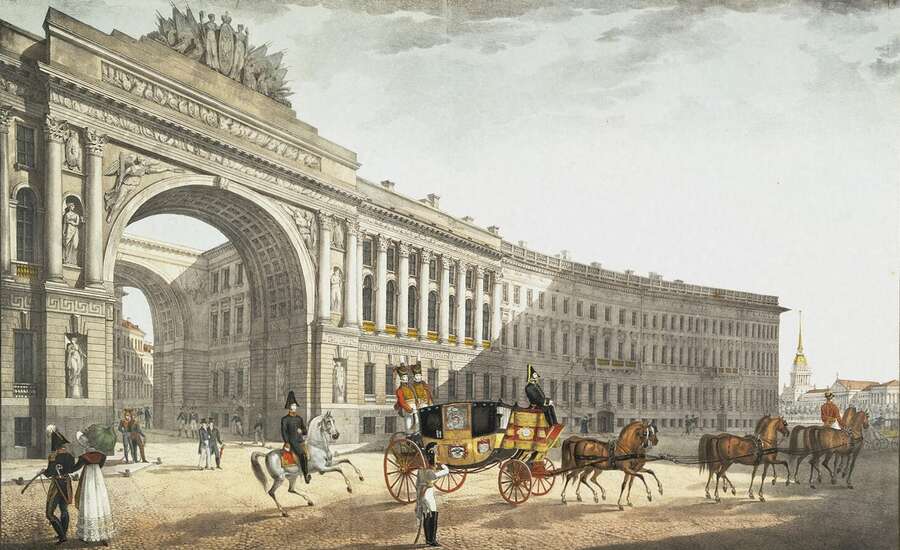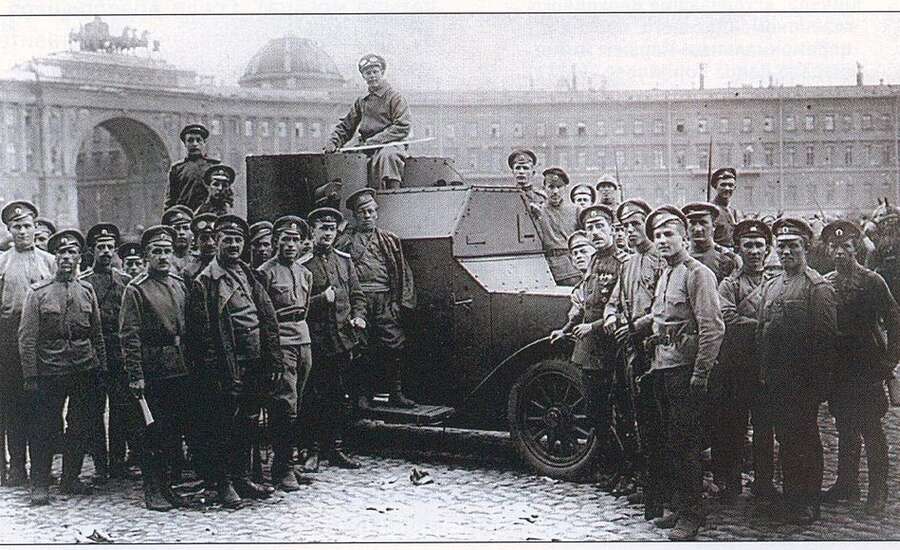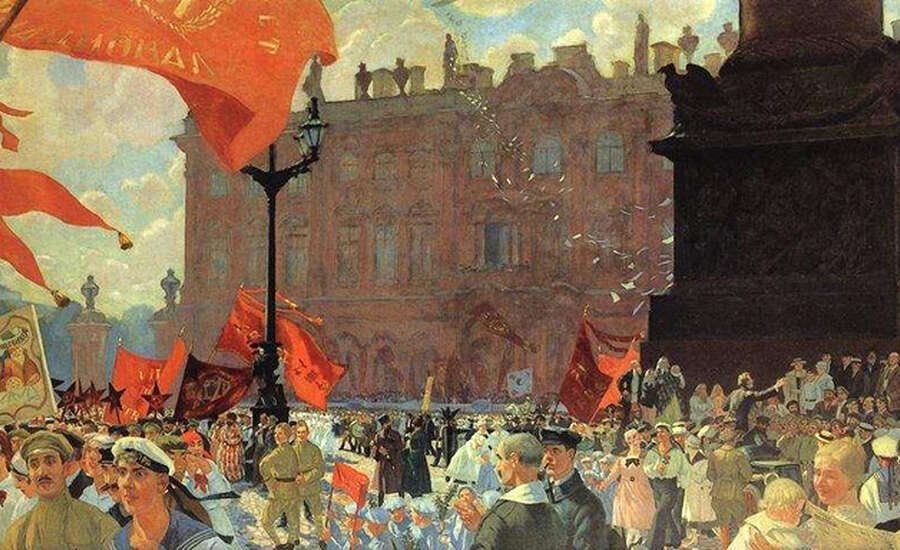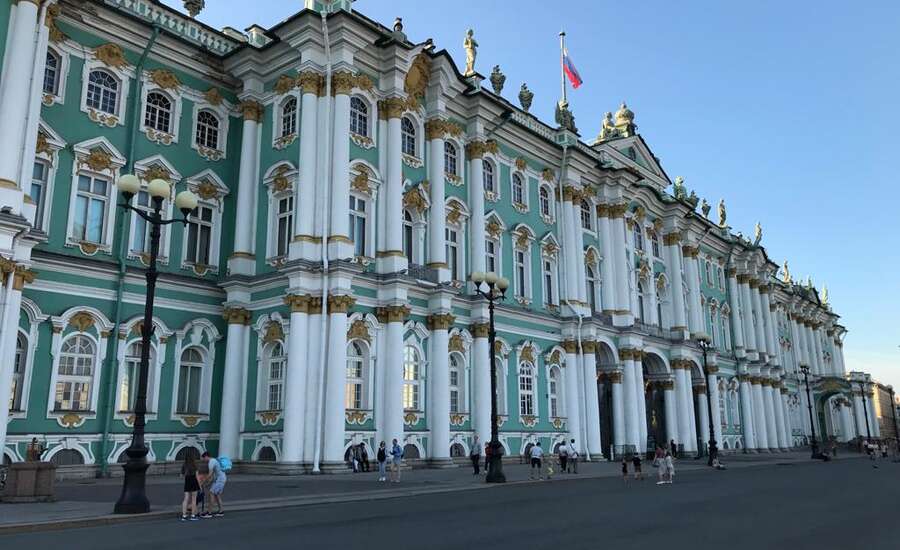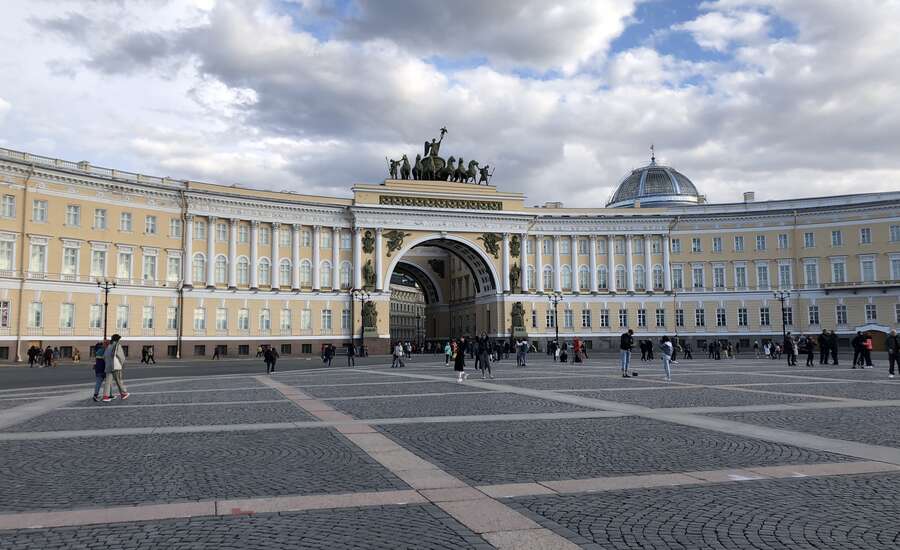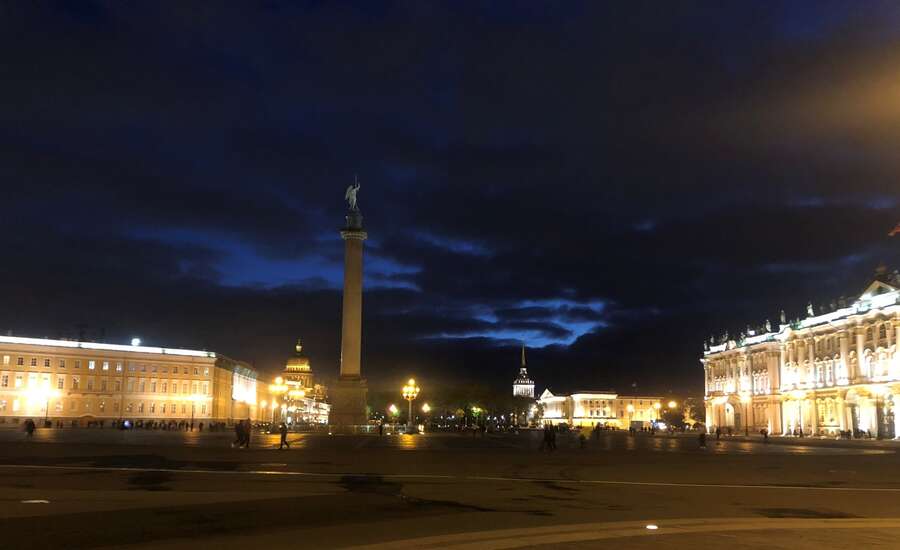The magnificent Palace Square forms the heart of historical St. Petersburg. Surrounded by some of the city’s most magnificent buildings, it is an architectural showcase and one of the prime tourist attractions in the city.
History
Palace Square
Palace Square seen
towards Admiralty Garden
Palace Square was laid out in 1819-1829 by Carlo Rossi, a Neoclassicist architect of Italian descent who designed many streets and squares in St. Petersburg. He was also responsible for one of the most monumental buildings along the square, the General Staff Building.
The square has a prominent place in the history of St. Petersburg. The massacre of ‘Bloody Sunday’ on January 22, 1905, when Tsarist troops fired on unarmed strikers, sparked the revolution of 1905. It also played an important part in the 1917 revolution, when a group of Bolshevik militants stormed the Winter Palace following a shot fired from the Aurora cruiser.
Today the enormous square is more peaceful. Locals often gather here, and tourists gaze at the architectural delights or stand in line for the Hermitage. Political rallies and official ceremonies still take place here, although today you’re more likely to see a concert or festival here.
Alexander Column
Alexander Column
The star attraction of the square is the immense column that sits in its center. Known as the Alexander Column, it is a monument to Russia’s victory over Napoleonic France. Designed, ironically, by the French-born architect Auguste de Montferrand and built between 1830 and 1834, the column stands at 47.4 meter or almost 156 feet (including the base) and is topped with an angel whose face is said to resemble that of Emperor Alexander I. The monument, considered a great feat of engineering, weighs six hundred tons. No cranes were used to place it in the square!
Surrounding Buildings
Winter Palace
General Staff Building
Admiralty
The buildings around the Palace Square exhibit a variety of architectural styles and serve various purposes. On the northern side is the grand Baroque-style Winter Palace, built between 1754 and 1762. The main residence of the Russian Tsars, this palace sits on the banks of the Neva River and serves as the main building for the excellent Hermitage Museum. Originally built for Empress Elizabeth, daughter of Peter the Great, the Winter Palace was largely remodeled on the inside after a fire in 1837 destroyed large portions of the interior. Today, the Hermitage houses several millions of objects, and it would take years, literally, to see everything there.
On the southern side is a yellow and white building that served as the former home of the Imperial Army General Staff and now houses government offices. It was constructed between the years 1819 and 1829 from plans created by Italian architect Carlo Rossi. The 520 meter (1700 ft.) wide building includes a monumental central arch, designed as a double Triumphal Arch. During the Romanov era, grand armies would parade through the arch. The arch leads to Nevsky Prospekt, the major thoroughfare through the city of St. Petersburg.
On the eastern side of Palace Square is the former Royal Guards’ General Staff building, now used for various government offices as well. On the west, the square borders the Admiralty and the Admiralty Garden. The Admiralty was one of the first structures to be built in the city of St. Petersburg. Constructed between 1806 and 1823 from a design by Adrian Zakharov, the Admiralty was Russia’s naval headquarters until 1917 and now serves as a naval college. The gardens sit in front of the building and are especially beautiful in the spring and summer months.
- Next: Church of the Savior on Spilled Blood
Situated in the heart of St Petersburg, Palace square is the main square of the city, adored by its residents and guests. It’s one of the most beautiful architectural ensembles of the world. Best Russian architects worked on its creation. The name of the square comes from the Winter Palace, built by Francesco Bartolomeo Rastrelli in the middle of the 18th century.
Nowadays Palace square is the centre of all public events and concerts, held in St Petersburg. It’s also the most popular place in the city among tourists.
History of the Palace Square
The pre-history of the Palace square relates to the foundation of the Admiralty fortress in 1704. According to the standards of the war times, the Admiralty had to be surrounded by shafts and ditches. There was a wide open space in front of them – a glacis necessary to expose attackers to the fortress defenders’ missiles.
Soon after its foundation, the Admiralty lost its function as a battle fortress, so did the glacis. At first the territory was used for storing the construction fleet forest, high anchors and other admiralty assets. During 1712-1717, the area of former glacis was partly used as a sea market, the territory got covered with grass and turned in the Admiralty meadow.
In 1721 under the initiative of Peter the Great, the basic scheme plan of St Petersburg in the shape of threus from the Admiralty was founded. Two rays (current Voznesensky Prospekt and Nevsky Prospekt) appeared in Peter’s times, the third one (current – Gorokhovaya Street) appeared in 1736-1737.
In Anna Ivanovna’s times, the area was a feast place with fireworks and festivities. Up to 1760s the Admiralty meadow was also occupied as an additional construction site of the Emperor’s Winter Palace. During the reconstruction breaks, it was utilized for combat training and grazing.
In 1753 Franceso Ranstrelli suggested organizing the widely spread area into the architectural central square of the capital. Together with creating the final version of the Winter palace, he also was also projecting the square. He planned to have the statue of Peter the Great in the centre of the square. In 1763 the Commission of Stone Construction published the contest with the aim of creating the general plan of the city. Since then, the formation of the Palace square as we know it now began.
Ensemble of the Palace Square
The square was formed in the second half of the 18th — the first half of the 19th centuries. It’s 5,4 hectares in size and is surrounded by the cultural and historical monuments, such as Winter Palace, Guard Headquarters Building, General Staff Building with the Triumph Arch. The Palace square is included in the list of the World Heritage and serves as a pedestrian area.
Winter Palace
From the square you can see the main facade of the Winter palace with the arch of the main passage. The ensemble also includes the Small Hermitage facing Millionnaya Street and the New Hermitage with the portico decorated with the giant statues of Atlants holding the ceiling.
General Staff Building
Along the southern border of the square you can see a long arcuate building of the General Staff, built in 1819-1829 by the architect Carlo Rossi. The complex spread up to 580 meters.
Two wings of the building are connected with the Triumphal Arch entrance that includes three interlinked arches, decorated with bas-relief. Arches are not located one after another, so when passing through each of them, you will gradually view the greatness and spaciousness of the square. On top of the Arch you can see a chariot with six horses that are guided by the majestic Goddess Glory with the laurel wreath in one hand and the standard in another one. The sculptural project was created by Stepan Pimenov and Vasily Demut-Malinovsky. The Arch was opened on October 24th in 1828.
The Alexander Column
In the centre of the square you can see the Alexander Column, created by Auguste de Montferrand in 1830-1834 under the order of Nicolas I. The column is made of a giant polished monolith of pink granite. Together with the pedestal and the figure of an Angel with a cross by the sculptor Boris Orlovskiy, the column is 47,5 meters high.
The Alexander Column and the Triumphal Arch of the General Staff Building are dedicated to Russian victory in the war against Napoleon. On the bottom of the column there is a table with a saying “To Alexander I grateful Russia”.
By the way, the column stays on the pedestal only thanks to its own weight.
Guard Headquarters Building
On the eastern side of the square you can see the building of the Guard Headquarters built in 1837—1843. The architect Alexander Briullov was challenged to create a building that would fit the styles of General Staff building classicism and Winter Palace baroque. Four-floored neutral building perfectly fits the ensemble and locks the Palace square from the eastern side.
Interesting Facts
- Just right before World War I all building on the Palace square were painted in dark red colors. So the revolutionary events of 1917 were greater dramatized by such a surrounding. Likely, in the 40s the building on the square got their bright historical colors back.
- After the revolution, the Palace square changed its name to the Square of Uritsky – the Chief of Cheka of Petrograd City, who was killed in the halls of the General Staff building on August 30th 1918. In 1944 the square got its historical name back.
- During World War II, all buildings on the Palace Square were disguised with a grey color.
- During the celebration of the year 2000, a petard got in the construction site around the Chariot and cause the fire. It took almost a year to restore the sculpture. Thereby, the administration of the Hermitage claimed to stop public celebrations on the square that can do harm to the historical heritage of St Petersburg.
No matter what these days the Palace Square attracts millions of visitors every year. It is one of the most popular sights of St Petersburg that you can visit as a part of private guided tour.
Information About the Excursion
Schedule
| All year round |
|---|
| Open all the time |
Public Transport
| Address | |
|---|---|
| Palace Square | |
| Metro / Subway | |
| Admiralteyskaya | |
| Buses | |
| Dvortsovaya Ploshad’, Malaya Morskaya Ulitsa | 2MA, 3M, 5M, 7, 24, 191 |
| Nevsky Prospekt | 3, 4M, 4MБ, 5МБ, 22, 27, 100 |
| Trolleys | |
| Malaya Morskaya Ulitsa | 1, 7, 10, 11 |
| Nevsky Prospekt | 5, 22 |
| Minibuses (marshrutka) | |
| Dvortsovaya Ploshad’ | K-252 |
Watch more
Share
Упражнение 8 для подготовки к ЕГЭ по английскому языку.
Прочитайте текст и заполните пропуски A–F частями предложений, обозначенными цифрами 1–7. Одна из частей в списке 1–7 лишняя.
текстответ
Pavlovsk Palace near St Petersburg has a remarkable story. In its over 200 years of existence, it has been ravaged by fire, A _______. But its survival of World War II is perhaps the most interesting period in its history
The palace was built in the late 18th century on land that belonged to Catherine the Great. She had passed the land down to her son, Paul I, and his wife, Maria, upon the birth of their son, Alexander I of Russia. Scottish architect Charles Cameron, a lover of Greek and Roman architecture, was hired to design the palace. His relationship with Catherine the Great was quite close, В ______ .
The three ol them had competing interests tor the interiors, each one disliking the others’ tastes. Eventually the palace was finished, and after Catherine the Great’s passing, Paul I made it the official royal residence. His death in 1801 meant Alexander I would become emperor, С _______ .
The palace stayed in royal hands up until the Russian Revolution, when the royal family fled the country They left the palace to Alexander Polovotsoff, a prominent museum director, who fought to have it saved as a museum. His success meant that the palace survived, D _______ .
Just before its seizure, the museum staff hurried to save the art contained in the museum. Furniture was dismantled and shipped off, E _______ .
Perhaps the cleverest trick involved the statues. They were too heavy to evacuate, so the staff buried them in the gardens. They sank them three metres into the ground, F _______ . They were right; after the occupation was over, the statues still remained.
1. occupied by foreign troops and nearly completely destroyed
2. and large antiquities were stored in a basement and walled up
3. but it would be seized by the Germans years later and used for military purposes
4. and he designated the house as his mother Maria’s official residence
5. believing the palace would best serve the country as a museum
6. but clashes would erupt between him, Paul and Maria over style issues
7. thinking the Germans wouldn’t dig that deep to look for them
A-1; B-6; C-4; D-3; E-2; F-7
Pavlovsk Palace
Pavlovsk Palace near St Petersburg has a remarkable story. In its over 200 years of existence, it has been ravaged by fire, occupied by foreign troops and nearly completely destroyed. But its survival of World War II is perhaps the most interesting period in its history
The palace was built in the late 18th century on land that belonged to Catherine the Great. She had passed the land down to her son, Paul I, and his wife, Maria, upon the birth of their son, Alexander I of Russia. Scottish architect Charles Cameron, a lover of Greek and Roman architecture, was hired to design the palace. His relationship with Catherine the Great was quite close, but clashes would erupt between him, Paul and Maria over style issues.
The three ol them had competing interests tor the interiors, each one disliking the others’ tastes. Eventually the palace was finished, and after Catherine the Great’s passing, Paul I made it the official royal residence. His death in 1801 meant Alexander I would become emperor, and he designated the house as his mother Maria’s official residence.
The palace stayed in royal hands up until the Russian Revolution, when the royal family fled the country They left the palace to Alexander Polovotsoff, a prominent museum director, who fought to have it saved as a museum. His success meant that the palace survived, but it would be seized by the Germans years later and used for military purposes.
Just before its seizure, the museum staff hurried to save the art contained in the museum. Furniture was dismantled and shipped off, and large antiquities were stored in a basement and walled up.
Perhaps the cleverest trick involved the statues. They were too heavy to evacuate, so the staff buried them in the gardens. They sank them three metres into the ground, thinking the Germans wouldn’t dig that deep to look for them. They were right; after the occupation was over, the statues still remained.
Прочитайте текст и заполните пропуски A–F частями предложений, обозначенными цифрами 1–7. Одна из частей в списке 1–7 — лишняя. Занесите цифры, обозначающие соответствующие части предложений, в таблицу.
Peter and Paul Fortress
The Peter and Paul Fortress in St. Petersburg, located on small Hare Island, is the historic core of the city. The history of St. Petersburg begins with the history of the fortress.
Since 1700 Russia had been fighting the Northern War against Sweden. By 1703 the lands by the Neva River were conquered. To protect them from the attacks of the Swedes it was necessary to build a strong outpost here. The fortress was founded on Hare Island 16 (27) May, 1703 by joint plan of Peter I and French engineer Joseph-Gaspard Lambert de Guerin. This day is well known A_______________________.
The fortress stretches from west to east with six bastions B_______________________. The Peter’s Gate on the east side, C_____________________, has remained since the time of Peter I. The Peter and Paul Cathedral, D_______________________ emperors and the monument of Russian baroque, was completed after the death of the emperor, in 1733. The weathervane as a golden angel with a cross, E_______________________, is one of the main symbols of the city. On the opposite side of the cathedral, there is the Mint building, constructed in the time of Paul I by architect A. Porto. Coinage was moved to the fortress F_______________________ in the time of Peter I. The Peter and Paul Fortress has never directly participated in any fighting. From the very beginning of its existence it was used as a political prison. Since 1924 the Peter and Paul Fortress has been a part of the Museum of the History of St. Petersburg.
1. as the day of the birth of St. Petersburg
2. which was designed by D. Trezzini
3. which was the burial place of Russian
4. and reminding of the rich history of the city
5. as the most protected part of the city
6. which is located on the spire of the cathedral
7. that are located at the corners
| Пропуск | A | B | C | D | E | F |
| Часть предложения |
Прочитайте текст и
заполните пропуски A–F частями предложений, обозначенными цифрами 1–7.
Одна из частей в списке 1–7 лишняя. Занесите цифры, обозначающие
соответствующие части предложений, в таблицу.
City
of fountains
Peterhof is a
monument of world architecture and palace and park art. Peterhof includes a
palace and park ensemble of the 18-19th centuries, A_______________________.
Peterhof is a city of fountains as it contains 173 fountains and 4 cascades B_______________________.
Each year up to 3 million people come here to enjoy the splendour of numerous
fountains and the unique parks of Peterhof.
The name
Peterhof was first mentioned in 1705. It was a coastal manor, close to which the
construction of a grand country residence began. The original plan belonged to
Peter the Great. After the brilliant victory of Russian troops over the Swedes,
security of St. Petersburg both from the land C_______________________.
Since that time, the construction of the Peterhof residence grew immensely in
scope.
According to the
plan of Peter the Great, on the one hand, Peterhof was meant to be equal in
splendour with the most famous royal residences in Europe, D_______________________
to access the Baltic Sea. Both were successfully done. The Great Palace was built on a natural hill here, E_______________________. Following the
plan of Peter the Great, F_______________________, the Grand Cascade
with the famous Samson fountain was constructed. This is still one of the most
spectacular fountains in the world. In 1990 the palaces and parks of Peterhof
were included in the list of the world heritage of UNESCO.
| 1. |
and from the sea has been firmly ensured |
| 2. |
which is a former royal countryside residence |
| 3. |
who designs many royal residences in Europe |
| 4. |
and then rebuilt in the baroque style in the 18th century |
| 5. |
who wanted to decorate the main entrance with waterfalls |
| 6. |
that are located in the park on the coast of the Gulf of Finland |
| 7. |
and on the other hand, to become a monument of Russia’s struggle |
What’s the history behind Palace Square?
- Imperial Russia: Palace Square took shape over 89 years with the involvement of some of St Petersburg’s most masterful architects, such as Francesco Rastrelli and Carlo Rossi
- Revolution: The First Russian Revolution of 1905 and the October Revolution of 1917 were sparked on the square, watershed moments in Russian history
- Soviet Russia: The square was renamed Aritsky Square from 1923 and 1944, and there were even plans to turn it into an airfield. Thankfully, Palace Square and its surrounding ensemble survived until the present day
St Petersburg’s largest and most magnificent square is undoubtedly Palace Square. A UNESCO World Heritage Site, the heart of Russian culture and history, and home to some of the city’s most famous attractions, no trip to St Petersburg would complete without a visit.
Imperial Russia
View of the Arch of the General Staff Building from Palace Square. Colored lithography, 1822, Karl Beggrov
The space where Palace Square now lies was initially a meadow used for livestock, markets and imperial festivities. The square itself was envisaged over an 89 year period, beginning in 1754 as part of Francesco Rastrelli’s designs for the Winter Palace, and finishing in 1843 with the construction of the Guard Corps.
Revolution
Junckers at Dvortsovaya, 1917, unknown author
Despite its beauty, Palace Square has been home to some dark events in Russian history. On 5th January 1905, workers assembling in Palace Square were gunned down by imperial soldiers, sparking the First Russian Revolution. This was not to be a one-off event. On 26th October 1917, the Winter Palace was seized by workers, soldiers and sailors. The October Revolution had begun, and the very first Soviet decree was declared that same day.
Did you know? Palace Square during the Soviet era wasn’t all doom and gloom. A game of “Live Chess” was organised there in 1924, with sailors in white and soldiers in black as the ‘chess pieces’. After 5 hours, the game ended in a draw.
Soviet Russia
Celebration in honor of the 2nd Congress of the Comintern on Uritsky Square, 1921, by B. Kustodiev
From 1923 until 1944, Palace Square was renamed Uritsky Square after Moisei Uritsky, head of the Petrograd Cheka, was assassinated on the square in 1918. During the Second World War it was proposed to transform Palace Square into an airfield; luckily this plan was abandoned. It’s interesting that, despite the Soviet destruction of countless imperial architectural masterpieces, Palace Square and its surrounding ensemble remained untouched.
Did you know? Mass participation theatrical performances were organised on Palace Square in the early Soviet state, the most famous being The Storming of the Winter Palace in 1920, a reenactment of the momentous event by 6,000 actors and watched by over 100,000 spectators.
What can you see in the Palace Square today?
- Winter Palace and State Hermitage Museum: St Petersburg’s most famous building and former imperial residence is now home to Russia’s largest art museum, which houses over 3 million exhibits
- General Staff Building: Curving for nearly 600m along the southern side of Palace Square, the General Staff is home to military headquarters as well as various art collections of the Hermitage
- Alexander Column: A vast monument to Russian victory over Napoleon, this is the largest free-standing monument in the world, whose size initially terrified the city’s residents
- Festivities: Palace Square can accommodate 120,000 people, making it the perfect site for many annual festivals, parades, concerts and other events
The Winter Palace and the State Hermitage Museum
Photo by Express to Russia staff
The most famous building on Palace Square is the Winter Palace, a white and turquoise masterpiece of Baroque architecture. Within the walls of the Winter Palace and its adjacent buildings is housed the State Hermitage, the second largest art museum on the planet.
The State Hermitage on Palace Square contains so many exhibits that, were you to peruse each one for just one minute, you would be there for 11 years. When you visit St.Petersburg, we would recommend to spend at least one full day at the Hermitage.
The General Staff Building
Photo by Express to Russia staff
Directly opposite the Winter Palace lies the General Staff Building, which curves for nearly 600 metres around the southern side of Palace Square. At the centre of the General Staff is the Triumphal Arch leading to Nevsky Prospekt. Today, the General Staff is home to various art collections of the Hermitage.
The Alexander Column
Photo by Express to Russia staff
The Alexander Column stands in the very centre of Palace Square, a vast monument to Russian victory over Napoleon. Atop the column is the figure of an angel said to resemble Tsar Alexander I. Nearly 50m high and weighing an incredible 700 tons, the Alexander Column is the largest and heaviest free-standing monument in the world.
Did you know? St Petersburg’s residents were so terrified that the monolithic structure would fall, that its architect, Auguste Montferrand, walked his dog around the column every evening just to reassure them!
There is a St Petersburg wedding custom that the groom should carry his new bride around the Alexander Column — however many times he does this predicts the number of children they will have!
Festivals and events
As Palace Square can accommodate up to 120,000 people, it is the ideal spot for festivities. The square hosts huge military parades, light shows, festivals and concerts. Even Madonna and Elton John have performed on Palace Square!
What can you visit nearby the Palace Square?
Aside from the Hermitage and General Staff building, many of St Petersburg’s top attractions lie close to Palace Square.
- St Isaac’s Cathedral, the largest church in Russia
- Nevsky Prospekt, St Petersburg’s magnificent main artery
- The River Neva and its bridges, especially gorgeous during the White Nights
- The River Moyka, a beautiful and serene river for strolling along
Essential Information for Visitors:
The nearest metro stations are Admiralteyskaya (500m) and Nevsky Prospekt (800m).
Прочитайте текст и заполните пропуски A–F частями предложений, обозначенными цифрами 1–7. Одна из частей в списке 1–7 — лишняя. Занесите цифры, обозначающие соответствующие части предложений, в таблицу.
Peter and Paul Fortress
The Peter and Paul Fortress in St. Petersburg, located on small Hare Island, is the historic core of the city. The history of St. Petersburg begins with the history of the fortress.
Since 1700 Russia had been fighting the Northern War against Sweden. By 1703 the lands by the Neva River were conquered. To protect them from the attacks of the Swedes it was necessary to build a strong outpost here. The fortress was founded on Hare Island 16 (27) May, 1703 by joint plan of Peter I and French engineer Joseph-Gaspard Lambert de Guerin. This day is well known A_______________________.
The fortress stretches from west to east with six bastions B_______________________. The Peter’s Gate on the east side, C_____________________, has remained since the time of Peter I. The Peter and Paul Cathedral, D_______________________ emperors and the monument of Russian baroque, was completed after the death of the emperor, in 1733. The weathervane as a golden angel with a cross, E_______________________, is one of the main symbols of the city. On the opposite side of the cathedral, there is the Mint building, constructed in the time of Paul I by architect A. Porto. Coinage was moved to the fortress F_______________________ in the time of Peter I. The Peter and Paul Fortress has never directly participated in any fighting. From the very beginning of its existence it was used as a political prison. Since 1924 the Peter and Paul Fortress has been a part of the Museum of the History of St. Petersburg.
1. as the day of the birth of St. Petersburg
2. which was designed by D. Trezzini
3. which was the burial place of Russian
4. and reminding of the rich history of the city
5. as the most protected part of the city
6. which is located on the spire of the cathedral
7. that are located at the corners
|
Пропуск |
A |
B |
C |
D |
E |
F |
G |
|
Часть предложения |
ЗаданПояснение.
A1 — Этот день хорошо известен «как день основания города»
B7 — bastions — множественное число. Нужен фрагмент, согласующийся с существительным во множественном числе, описывающий эти бастионы. that ARE located.
C2 — пропущенный отрывок — non-defying clause, уточняющее придаточное, выделяется запятыми, может быть убрано из предложения без потери смысла, дает дополнительную информацию.
D3 — после пропуска идет слово emperors, императоры. Предыдущий фрагмент связан по смыслу и грамматике.
E6 — Weathervane — флюгер, может быть только на шпиле (spire of the cathedral).
F5 — Пропущенный фрагмент объясняет, почему монетный двор был переведен в крепость.
Ответ: 172365
11 № 3586
Установите соответствие между текстами A–G и заголовками 1–8. Запишите свои ответы в таблицу. Используйте каждую цифру только один раз. В задании один заголовок лишний.
1. Reasons to be afraid
2. Fight your fear
3. A place of wonders
4. How to say thank you
5. Visiting for wild life and animals
6. Learn to be grateful
7. It’s never late to learn
8. Reading non-verbal language
A. Nowadays when it’s all too easy to send an email or text, the best way to show that you are grateful to somebody is to actually mail a hand-written card. The person who gets it will know you took the extra time and thought to write a card and put it in the mail with a nice stamp. That person will appreciate your efforts much more. Plus, you’ll get the added bonus of feeling grateful a little longer than usual as you write out each note and wait for it to arrive.
B. Music is a noble passion, and people who can play a musical instrument have always been seen as intelligent people. Learning how to play a musical instrument is far more efficient if you do it in childhood. However, there are millions of adults who learn to enjoy music throughout their lives. Moreover, they don’t focus on just one instrument, but specialize in two or even more, if they have the time and the necessary ambition.
C. Millions of people avoid air travel each year because of their fear of flying. The fear of accidents happening is probably the most common fear among air travellers. It is an understandable fear, since there have been many aviation accidents throughout history. Some people may have a fear that the plane has some type of malfunction or breakdown, while others may have a fear that the weather or turbulance will affect the plane.
D. Try to understand that being scared is just an illusion that makes you limited and miserable. Take control of your mind and don’t let your imagination create frightening pictures in your head. If you cannot deal with it, you should make attempts to leave your comfort zone. Choose things and activities you are afraid of and meet your worries face to face, because it is impossible to run away from them. Just face your troubles no matter how powerful they may seem.
E. When you get chronically bored with something, your mind gets used to seeing the world negatively. It is necessary to break the chain of negative thoughts and train your mind to notice the best. Just write down 5 things you are thankful for. This way, your mind will change for the better in a while. The thankfulness will open your eyes to the beauty of the world around you and will help you to focus on positive moments in your life.
F. If you go to Ireland, go to isolated distant places in the country, talk to the locals and they will tell you the stories about the mythical Irish place, called the Otherworld. They believe that it is the land of paradise and happiness. In Irish poetry and tales, it is described as a series of islands near Ireland where the various fairytale creatures lived. Also the Otherworld seemed to be able to move from one location to another.
G. Many people can understand the nature of character without talking to the person they are interested in. The gestures and postures usually reflect the mood and the level of the person’s confidence. It’s easy to notice a highly confident person even in a big group of people. They stand in one place without constant moving from place to place, and they always make eye contact with the person they are talking to.
|
Текст |
A |
B |
C |
D |
E |
F |
G |
|
Заголовок |
Пояснение.
A4 — the best way to show that you are grateful to somebody is to actually mail a hand-written card.
B7 — However, there are millions of adults who learn to enjoy music throughout their lives.
C1 — Some people may have a fear that the plane has some type of malfunction or breakdown, while others may have a fear that the weather or turbulance will affect the plane.
D2 — Take control of your mind and don’t let your imagination create frightening pictures in your head.
E6 — write down 5 things you are thankful for. This way, your mind will change for the better in a while.
F3 — the land of paradise and happiness… where the various fairytale creatures lived.
G8 — Many people can understand the nature of character without talking. he gestures and postures usually reflect the mood and the level of the person’s confidence.
Ответ: 4712638


